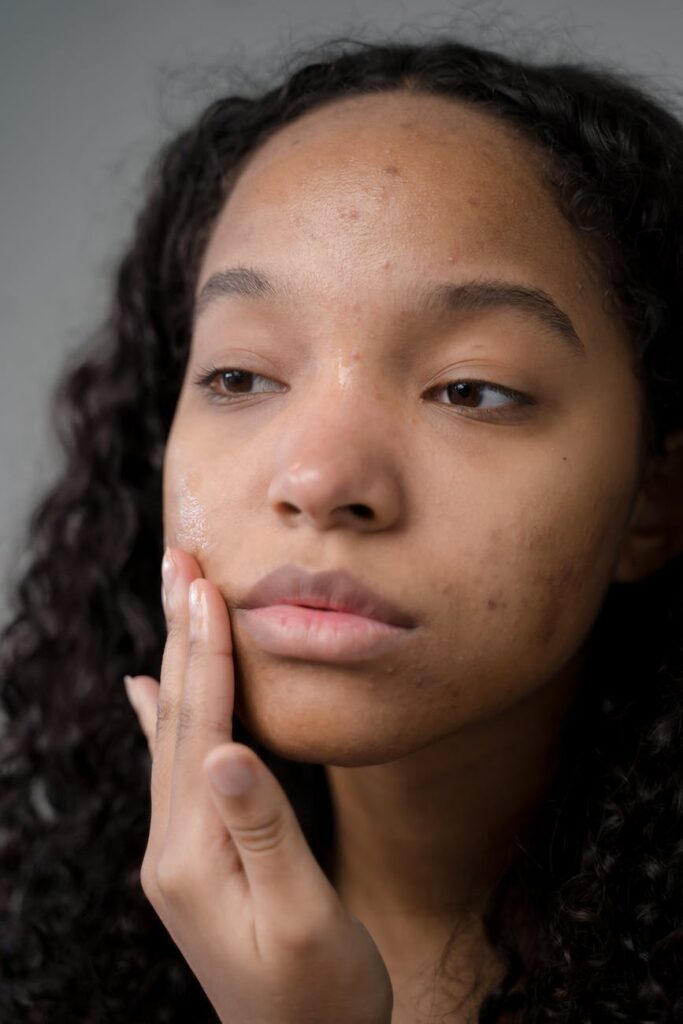Views: 0
Table of Contents
Acne vulgaris
Acne vulgaris is a common skin disease characterized by tiny pimples, blackheads, and whiteheads on the face, neck, and chest. It is usually due to the overproduction of sebum by the sebaceous glands in the skin.
Sebum is a natural oily secretion present in all parts of the body. The sebum helps keep the skin soft and protects it from external irritants. Excessive sebum production can cause extreme skin oiliness, leading to acne.
The causes of acne can be related to genetic factors, hormonal changes, pollution, and stress. The condition may also arise due to skin disease, improper hygiene, use of some cosmetic products, etc.
The acne starts as whiteheads. They appear as small white bumps on the surface of the skin. They are very tiny, and it is hard to see them under the skin. After some time, these whiteheads break into a fluid-filled pore on the white, brown, green, or red skin. It is known as a pore. Acne can be quite painful. The pores become inflamed, causing them to pore to become darker. It may result in redness and swelling of the pore.
Acne is more common among teenage girls and young adults. The condition may become more evident and noticeable when an individual begins puberty. The disease affects some people more than others. As the condition worsens, individuals may develop scarring of the skin. Some treatments may help combat acne. Particular lifestyle and diet changes can help treat the disease.
What are the causes of acne vulgaris?
Acne is a common skin condition characterized by tiny pimples, blackheads, and whiteheads on the face, neck, and chest. The overproduction of sebum by the sebaceous glands in the skin usually causes acne. Sebum is a natural oily secretion present in all parts of the body. The sebum helps keep the skin soft and protects it from external irritants. Excessive sebum production may cause excessive skin oiliness, leading to acne.
The causes of acne can be related to genetic factors, hormonal changes, pollution, and stress. Acne can also be due to skin disease, improper hygiene, use of some cosmetic products, etc.
The condition may become more evident and noticeable when an individual begins puberty. The disease affects some people more than others. As the condition worsens, individuals may develop scarring of the skin.
In acne vulgaris, the skin cells shed, which causes the skin to look itchy. Many bacteria are present in the pores, and the skin can become infected. These may cause redness and inflammation of the pore.
What are the types of acne vulgaris?
There are no types of acne vulgaris. But the most common forms are:
Nodular acne
Cystic acne
Convention acne
Inflammatory acne
Acne may appear as tiny pimples and blackheads on the skin. They are more common in teenagers. In addition, whiteheads, pimples, and nodules may be present or not considered acne. These occur more in young adults.

What are the symptoms of acne vulgaris?
The most commonly affected area of the body is the face. Acne may appear as bumps and pimples on the skin. The spots appear as whiteheads, blackheads, and pimples. In addition, it is also possible to find comedones (boils) and nodules in the affected area. Other symptoms of acne may include skin scarring, cysts, acne keloidalis nuchae, and hormonal changes.
The acne may begin as whiteheads. They appear as small white bumps on the surface of the skin. These are hard to see under the skin. If you rub the skin, it is possible to feel the spots.
These whiteheads break into a fluid-filled pore on the white, brown, green, or red skin. The affected area is known as the pore.
After some time, the pore becomes inflamed, causing the pore to become darker. It may result in redness and swelling of the pore.
Other skin problems that are common in individuals with acne include the following:
Acne conglobata
Acne conglobata with nodules
Hormonal changes
Black marks on the chin
Troughs on the chin
Bald spots
What are the risk factors for acne vulgaris?
Several factors can play a role in developing acne vulgaris. These may be related to family history, diet, hormones, stress, and certain medicines.
Genetics: Some individuals are more prone to acne vulgaris than others. Genetics plays a role in the development of acne.
Hormones: Stress and changes in hormonal levels in the body may be responsible for acne.
Skin disease: Skin diseases may also cause acne.
Stress: A stressful environment may also lead to acne vulgaris.
How is acne vulgaris diagnosed?
The diagnosis of acne vulgaris is easy to make. Your doctor will take a physical examination of your skin. The doctor will check for acne vulgaris in specific places, such as the face, chest, and back. The doctor will take blood tests, x-ray, and lab tests to diagnose any other possible skin conditions present.
It is possible to diagnose acne with a simple examination of the skin. As part of the examination, the doctor will examine your skin for lumps or bumps, pimples, acne scars, or acne nodules. Your doctor may take some of your tissue samples for testing. The doctor will ask you about your medications and how you cope with your condition.
It is possible to diagnose acne with a simple examination of the skin. As part of the examination, your doctor will examine your skin for lumps or bumps, pimples, acne scars, or acne nodules. The doctor will ask you about your medications and how you cope with your condition.
At the same time, the doctor will take a blood test. It will help your doctor to make a more informed diagnosis.

